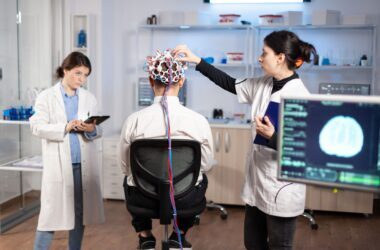The quality of healthcare outcomes depends on patients’ medication adherence to recommended treatment regimens. However in certain disease conditions, more than 40% of patients are at risk due to misunderstanding, forgetfulness, or ignoring healthcare advice.
This communication gap between patients and healthcare providers can lead to negative and undesired consequences, including medication non-adherence, poorer health outcomes, increased patient dissatisfaction, and, in certain cases, considerable economic burden. Fortunately, innovative technologies like Decision Support Tools (DSTs) are emerging as robust tools to bridge this gap and create a more collaborative approach to healthcare.
This blog highlights the role of DSTs in improving the patient and caregiver relationships and ultimately the care delivery outcomes.
Content Index:
- The Challenge – A system ripe for improvement
- Bringing seamless collaboration with Decision Support Tools
- Empowering patients through information and education
- Overcoming language barriers and literacy gaps
- Mitigating patient anxiety – The role of DSTs
- Beyond the consultation room – Sustaining communication
The Challenge – A System Ripe For Improvement
Effective communication is, without doubt, the cornerstone of quality healthcare. However, the traditional doctor-patient interaction often encounters complexities triggered by many factors. Complicated medical terminology, time constraints during consultations, and patient anxiety can all contribute to misunderstandings and a sense of disempowerment for patients. Further, the paternalistic model of care, where the doctor dictates treatment plans, may not always align with the growing desire for patient autonomy and shared decision-making.
Bringing Seamless Collaboration With Decision Support Tools
DSTs represent a promising advancement in healthcare technology. These AI-powered tools are designed to assist healthcare providers in making clinical decisions while simultaneously empowering patients to participate actively in their care movement. By harnessing vast medical databases and tailoring information to individual patient needs, DSTs offer a unique opportunity to optimize communication dynamics within the healthcare system.
Empowering Patients Through Information And Education
DSTs have greatly impacted patients by giving them more knowledge and understanding about their health. These tools can present information about diagnoses, treatment options, possible risks and benefits, and alternative therapies in an easy-to-understand way. The information can be customized using simple language, visuals, and interactive elements to fit the patient’s needs. In other words, patients can learn more about their health and treatment options in a way that works best for them, thus resulting in more patient satisfaction.
The emergence of decision support tools (DSTs) aligns with the healthcare industry’s shift towards shared decision-making. Initiatives such as OpenNotes, which encourage sharing clinical notes with patients, underscore the significance of involving patients in their own healthcare. DSTs support this trend by empowering patients with the information and materials they require to participate actively in discussions about their treatment plans.
Overcoming Language Barriers And Literacy Gaps
For a truly inclusive healthcare system, communication tools need to cater to diverse populations. DSTs can be designed to address language barriers by offering multilingual capabilities and audio explanations. In addition, features such as the use of simple language with visual aids can enhance comprehension for individuals and patients with different levels of health literacy.
Mitigating Patient Anxiety – The Role Of Decision Support Tools
Patient anxiety during consultations can be a significant hurdle to effective communication. Fear and confusion can impede information retention, hinder the ability to ask questions, and ultimately lead to suboptimal decision-making about treatment options. Fortunately, Decision Support Tools play a crucial role in addressing patient anxiety through several key functionalities:
- Clear And Concise Information: DSTs can present diagnoses, treatment options, and possible outcomes in a clear, concise, and easily understandable format. This reduces confusion and empowers patients with knowledge, fostering a sense of control and reducing anxiety.
- Visualization Tools: Complex medical information can be overwhelming. DSTs can utilize visuals like images, diagrams, and animations to simplify medical concepts. This visual representation allows for easier comprehension and reduces anxiety associated with understanding unfamiliar medical terminology.
- Interactive Features: Many DSTs offer interactive features that allow patients to explore different treatment options and potential outcomes at their own pace. This empowers patients to take ownership of their healthcare decisions and reduces the feeling of being rushed or overwhelmed during consultations.
- Anxiety-Reducing Interface: The design of the DST interface itself can contribute to reducing anxiety. Features like a user-friendly layout, clear navigation, and accessible information retrieval can create a calming and empowering experience for patients.
By equipping patients with knowledge, simplifying complex information, and cultivating a sense of control, DSTs act as robust tools in mitigating patient anxiety and promoting a more collaborative healthcare environment.
Beyond The Consultation Room – Sustaining Communication
The benefits of DSTs extend beyond the initial doctor’s visit. These tools can facilitate ongoing communication between patients and providers through features like:
Educational Resources: Empowering patients with access to a library of educational materials and decision aids related to their condition and treatment options allows for continued learning and informed decision-making.
Personalized Communication Tools: Secure messaging functionalities within DSTs enable patients to ask follow-up questions, receive medication reminders, and report any concerns after the consultation. This approach encourages a more collaborative and continuous care experience.
Medication Management Tools: DSTs can integrate with medication adherence programs, sending reminders and tracking medication intake. This approach can boost treatment adherence rates and overall health outcomes.
However, the potential of DSTs in healthcare communication extends far beyond the functionalities listed above. Looking ahead, we can expect to see further integration of AI chatbots to assist with patient education, appointment scheduling, and symptom management. Moreover, advancements in personalized communication tools will allow for tailoring information and recommendations based on individual patient needs and preferences.
Final Words
The current communication gap in healthcare poses a significant barrier to optimal patient care. Decision Support Tools offer a powerful solution, empowering patients with knowledge, encouraging collaboration with providers, and ultimately leading to better health outcomes. Healthcare professionals and organizations should actively explore and embrace the potential of DSTs. By integrating these innovative tools into their practice, the industry can move towards a future of healthcare communication characterized by shared decision-making, patient empowerment, and a more holistic approach to care delivery.














